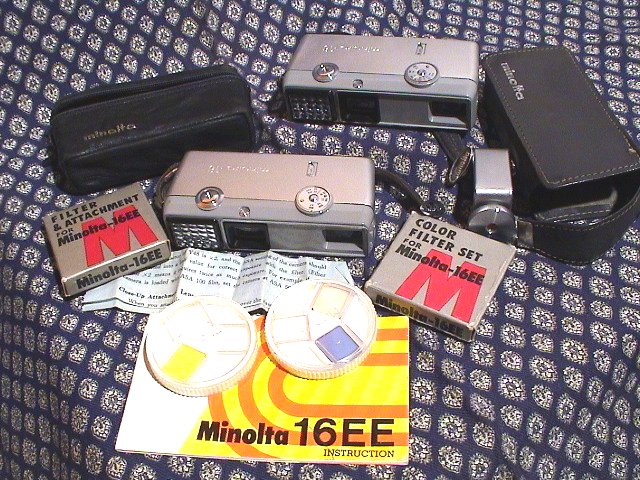
introduction | 16EE (button case, 'Lens' on left) | 16EE (zip case, 'Lens' on right) | 16EE (button case, 'Lens' on right | compared | accessories

The Minolta 16 EE was introduced in 1962 and soon replaced by the 16 EE II, two years later. This is the first model to be fitted with a light meter. The selenium light meter operated the automatic exposure, a "manual-programmed/shutter preferred" exposure method.
The lens is a Rokkor f2.8 25mm lens and the shutter 1/30, 1/50, 1/100, 1/200 and 1/400 s.
Setting the film speed also sets the shutter speed.
| ASA | Shutter Speed |
| 25 | 1/30 |
| 50 | 1/60 |
| 100 | 1/125 |
| 200 | 1/250 |
| 400 | 1/400 |
Setting the dial on the back of the camera to "AUTO" the camera's meter set the correct f-stop (f2.8-16). A green bulb in the upper right-hand corner of the viewfinder indicate if there is enough light for the exposure.
For flash, the film speed dial was set at 25 or 50, to set the shutter speed. Then a dial on the back of the camera was set to "flash", which set the aperture to f11 (see pages 16 and 22 of the manual). The guide number of the flash would be used to determine the correct distance to the subject.
The lens provides for zone focusing with portrait (2.5 metres (6-7 feet)) for close up and landscape (5 metres (16 feet) to infinity). Two close up lens where available. No. 1 is designed for close-up of 1.2M (about 4 feet), No.2 for close-ups of 0.7m (about 2.5 feet). The viewer has a line to indicate a parallax correction when taking subjects at less than 1m.
The shutter release has a built-in cable release socket. The base has a tripod socket which is used to hold the flash bracket / cold shoe.
The UV filter was supplied with the camera and is removable. Filters and close up lens where supplied in a plastic case. 1A, 81A and 80A as the filter set and the Y48 (Yellow) filter supplied with No.1 and No.2 close-up lenses. Filters are interchangeable with the 16EEII.
The camera was also supplied with a a zip up case and wrist strap.
Variations are limited to the printed wording on the back of the camera, the style of the accompanying leather case and packaging.
In 1962, the camera and case cost about £29. The last list price in 1964 in the USA was $79.50.
| Years of production | 1962-1964 |
| Lens | 25mm Rokkor |
| Aperture | f2.8-16 |
| Shutter Speeds | 1/30- 1/400 |
| Film Speed | 25-400ASA (15-27DIN) |
| Flash sync. | class bulb electronic flash |
| Negative Size | 10x14mm |
| Finishes | chrome/grey plastic front |
| Supplied | case, wrist strap, UV Filter |
| Manuals | English: ME303 I |
| Dimensions |
| Filters | UV, Y48(Yellow), 1A-skylight (1.1x), 80A (3.2x), 81B (1.3x). |
| Auxiliary lenses | Close-up #1, #2. |
| Attachment Sets | No.1, No.2, Y48 1A, 80A, 81B |
| Flash and Tripod Clamp | C clamp holds flash unit and includes a tripod socket - compatible with those used for the P and Ps. |
| Flash | Baby Flashgun III with flip up reflector |
| Projector | Mini 16 |
| Enlarger | Minolta Mini Enlarger with f4.5 30mm Rokkor lens. |
| Minolta Viewer | Built in illuminator magnification x9 |
| Developing Tank |
Last updated 29th August 2005